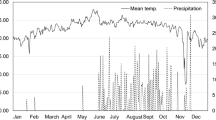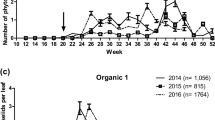Abstract
Commercial orchards have acarine communities that are reduced in biological diversity compared to their undisturbed counterparts. Examining the phenology of an unsprayed orchard allows for the examination of non-pesticide factors that drive changes in populations. This study examined the mite community in a largely unsprayed research orchard in 2013–2014. The phytoseiids Galendromus flumenis (Chant), Amblydromella caudiglans (Schuster), Kampimodromus corylosus Kolodochka, and Galendromus occidentalis (Nesbitt) were found, in addition to Zetzellia mali (Ewing) and Aculus schlechtendali (Nalepa). Although G. occidentalis is typically the dominant phytoseiid in commercial orchards, G. flumenis was much more abundant in this unsprayed block. Aculus schlechtendali appeared to be the main source of prey for all predator species. The availability of this prey item and the lack of pesticides are likely the factors that allowed for G. flumenis to reach high abundances. Tetranychids were scarce, emphasizing the role of these mites as induced pests; without the application of disruptive sprays, the predatory mite community was able to maintain biological control. This study demonstrates that the species complex of generalist phytoseiids that is present in orchard systems undisturbed by pesticides is sufficient to maintain spider mite populations below damaging levels throughout the season.




Similar content being viewed by others
References
Beers EH, Hoyt SC (1993a) European red mite. In: Beers EH, Brunner JF, Willett MJ, Warner GM (eds) Orchard pest management: a resource book for the Pacific Northwest. Good Fruit Grower, Yakima, WA, pp 136–144
Beers EH, Hoyt SC (1993b) Twospotted spider mite. In: Beers EH, Brunner JF, Willett MJ, Warner GM (eds) Orchard pest management: a resource book for the Pacific Northwest. Good Fruit Grower, Yakima, WA, pp 130–132
Beers EH, Brunner JF, Dunley JE, Doerr M, Granger K (2005) Role of neonicotinyl insecticides in Washington apple integrated pest management. Part II. Nontarget effects on integrated mite control. J Insect Sci 5(1):16
Blackwood JS, Luh H-K, Croft BA (2004) Evaluation of prey-stage preference as an indicator of life-style type in phytoseiid mites. Exp Appl Acarol 33:261–280
Clements DR, Harmsen R (1990) Predatory behavior and prey-stage preferences of stigmaeid and phytoseiid mites and their potential compatibility in biological control. Can Entomol 122:321–328
Clements DR, Harmsen R (1993) Prey preferences of adult and immature Zetzellia mali Ewing (Acari: Stigmaeidae) and Typhlodromus caudiglans schuster (Acari: Phytoseiidae). Can Entomol 125:967–969
Congdon BD (2002) The family Phytoseiidae (Acari) in western Washington State with descriptions of three new species. Int J Acarol 28:3–27
Croft BA (1993) Zetzellia mali (Ewing). In: Beers EH, Brunner JF, Willett MJ, Warner GM (eds) Orchard pest Management: a resource book for the Pacific Northwest. The Good Fruit Grower, Yakima, pp 228–229
Croft BA, Jorgensen CD (1969) Life history of Typhlodromus mcgregori (Acarina: Phytoseiidae). Ann Entomol Soc Am 63:1261–1271
Croft BA, Jorgensen CD (1977) Typhlodromus mcgegori (Acarina: Phytoseiidae) and its potential control of phytophagous mites in southern California and central Utah apple orchards. Great Basin Nat 37:366–374
Croft BA, Luh H-K (2004) Phytoseiid mites on unsprayed apple trees in Oregon, and other western states (USA): distributions, life-style types and relevance to commercial orchards. Exp Appl Acarol 33:281–326
Croft BA, MacRae IV (1992) Persistence of Typhlodromus pyri and Metaseiulus occidentalis (Acari: Phytoseiidae) on apple after inoculative release and competition with Zetzellia mali (Acari: Stigmaeidae). Environ Entomol 21:1168–1177
Croft BA, MacRae IV (1993) Biological control of apple mites: impact of Zetzellia mali (Acari: Stigmaeidae) on Typhlodromus pyri and Metaseiulus occidentalis (Acari: Phytoseiidae). Environ Entomol 22:865–873
Croft BA, Blackwood JS, McMurtry JA (2004) Classifying life-style types of phytoseiid mites: diagnostic traits. Exp Appl Acarol 33:247–260
Denmark HA, Evans GA (2011) Phytoseiidae of North America and Hawaii (Acari: Mesostigmata). Indira Publishing House, West Bloomfield
Downing RS, Moilliet TK (1972) Replacement of Typhlodromus occidentalis by T. caudiglans and T. pyri (Acarina: Phytoseiidae) after cessation of sprays on apple trees. Can Entomol 104:937–940
Duke KM, Croft BA, Jorgensen CD (1970) Distribution and searching behavior of Typhlodromus mcgregori. J Econ Entomol 63:221–227
Dyer JG, Swift FC (1979) Sex ratio in field populations of phytoseiid mites (Acarina: Phytoseiidae). Ann Entomol Soc Am 72:149–154
Funayama K, Komatus M, Sonoda S, Takahashi I, Hara K (2015) Management of apple orchards to conserve generalist phytoseiid mites suppresses two-spotted spider mite, Tetranychus urticae (Acari: Tetranychidae). Exp Appl Acarol 65:43–54
Hadam JJ, Aliniazee MT, Croft BA (1986) Phytoseiid mites (Parasitiformes: Phytoseiidae) of major crops in Willamette Valley, Oregon, and pesticide resistance in Typhlodromus pyri Scheuten. Environ Entomol 15:1255–1263
Hanna R, Wilson T (1991) Prey preference by Metaseiulus occidentalis (Acari: Phytoseiidae) and the role of prey aggregation. Biol Control 1:51–58
Hoy MA (1985) Recent advances in genetics and genetic improvement of the Phytoseiidae. Annu Rev Entomol 30:345–370
Hoyt SC (1969a) Integrated chemical control of insects and biological control of mites on apple in Washington. J Econ Entomol 62:74–86
Hoyt SC (1969b) Population studies of five mite species on apple in Washington. In: Evans GO (ed) Proceedings, 2nd international congress of acarology, 19–25 July 1967, Sutton Bonington, UK. Akadémiai Kiadó, Budapest, pp 117–133
Hoyt SC (1991) Biology, ecology and control of mites in Washington orchards. In: Williams K (ed) New directions in tree fruit pest management. Good Fruit Grower, Yakima, pp 147–156
Hoyt SC, Westigard PH, Burts EC (1978) Effects of two synthetic pyrethroids on the codling moth, pear psylla, and various mite species in Northwest apple and pear orchards. J Econ Entomol 71:431–434
Huffaker CB, Van de Vrie M, McMurtry JA (1970) II. Tetranychid populations and their possible control by predators: an evaluation. Hilgardia 40:391–458
Kolodochka KA (2003) A new species of the genus Kampimodromus (Parasitiformes, Phytoseiidae) from Ukraine and Moldova. Acarina 11:51–55
Martinez-Rocha L, Beers EH, Dunley JE (2008) Effect of pesticides on integrated mite management in Washington State. J Entomol Soc B C 105:1–12
McMurtry JA (1992) Dynamics and potential impact of ‘generalist’ phytoseiids in agroecosystems and possibilities for establishment of exotic species. Exp Appl Acarol 14:371–382
McMurtry JA, Croft BA (1997) Life-styles of phytoseiid mites and their roles in biological control. Annu Rev Entomol 42:291–321
McMurtry JA, Huffaker CB, van de Vrie M (1970) I. Tetranychid enemies: their biological characters and the impact of spray practices. Hilgardia 40:331–390
McMurtry JA, de Moraes GJ, Famah Sourassou N (2013) Revision of the lifestyles of phytoseiid mites (Acari: Phytoseiidae) and implications for biological control strategies. Syst Appl Acarol 18:297–320
Oatman ER (1973) An ecological study of arthropod populations on apple in northeastern Wisconsin: population dynamics of mite species on the foliage. Ann Entomol Soc Am 66:122–131
Oatman ER (1976) An ecological study of arthropod populations on apple in northeastern Wisconsin: phytoseiid mite species on the foliage. Environ Entomol 5:63–64
Prischmann DA, James DG (2003) Phytoseiidae (Acari) on unsprayed vegetation in southcentral Washington: implications for biological control of spider mites on wine grapes. Int J Acarol 29:279–287
Prischmann DA, James DG, Wright LC, Teneyck RD, Snyder WE (2005) Effects of chlorpyrifos and sulfur on spider mites (Acari: Tetranychidae) and their natural enemies. Biol Control 33:324–334
Putman WL (1962) Life-history and behaviour of the predacious mite Typhlodromus (T.) caudiglans Schuster (Acarina: Phytoseiidae) in Ontario, with notes on the prey of related species. Can Entomol 94:163–177
Rathman RJ, Brunner JF (1990) Abundance and composition of predators on young apple, Malus domestica Borkhausen, within sagebrush and riparian species pools in north central Washington. Melandria 46:65–81
Readshaw JL (1975) The ecology of tetranychid mites in Australian orchards. J Appl Ecol 12:473–495
Rioja T, Vargas R (2009) Life table parameters and consumption rate of Cydnodromus picanus Ragusa, Amblyseius graminis Chant, and Galendromus occidentalis (Nesbitt) on avocado red mite Oligonychus yothersi (McGregor) (Acari: Phytoseiiday, Tetranychidae). Chil J Agric Res 69:160–170
Santos MA (1976) Evaluation of Zetzellia mali as a predator of Panonychus ulmi and Aculus schlectendali. Environ Entomol 5:187–191
SAS Institute (2013) Using JMP 11. SAS Institute, Cary, NC
Schmidt-Jeffris RA, Beers EH (2015) Comparative biology and pesticide susceptibility of Amblydromella caudiglans and Galendromus occidentalis as spider mite predators in apple orchards. Exp Appl Acarol 67:35–47
Schmidt-Jeffris RA, Beers EH, Crowder DW (2015) Phytoseiids in Washington commercial apple orchards: biodiversity and factors affecting abundance. Exp Appl Acarol 67:21–34
Strickler K, Cushing N, Whalon M, Croft BA (1987) Mite (Acari) species composition in Michigan apple orchards. Environ Entomol 16:30–36
Thistlewood H (1991) A survey of predatory mites in Ontario apple orchards with diverse pesticide programmes. Can Entomol 123:1163–1174
Tixier M-S, Kreiter S, Croft BA, Cheval B (2008) Kampimodromus aberrans (Acari: Phytoseiidae) from the USA: morphological and molecular assessment of its density. Bull Entomol Res 98:125–134
Villanueva RT, Harmsen R (1998). Studies on the role of the stigmaeid predator Zetzellia mali in the acarine system of apple foliage. In: Harmsen R (ed) Proceedings, entomological society of Ontario, Sudbury, Ontario. Entomological Society of Ontario, pp. 149–155
Woolhouse MEJ, Harmsen R (1985). The mite complex on the foliage of a pesticide-free apple orchard: population dynamics and habitat associations. In: Ellis CR, Kevan PG, Pree DJ, Trimble RM (eds), Proceedings, entomological society of Ontario. Entomological Society of Ontario, pp. 1–11
Acknowledgments
The authors gratefully acknowledge the technical help of Jordan Takasugi. We would also like to thank James McMurtry for assistance with phytoseiid identifications.
Author information
Authors and Affiliations
Corresponding author
Rights and permissions
About this article
Cite this article
Schmidt-Jeffris, R.A., Beers, E.H. Phenology and structure of a phytoseiid community in an insecticide-free apple orchard. Exp Appl Acarol 68, 173–182 (2016). https://doi.org/10.1007/s10493-015-9977-1
Received:
Accepted:
Published:
Issue Date:
DOI: https://doi.org/10.1007/s10493-015-9977-1




